Build Your Own Self Watering Containers
This post may contain affiliate links, which means that I may receive a commission if you make a purchase using these links. As an Amazon Associate I earn from qualifying purchases.
Many versions of self watering containers, also known as self watering grow boxes, self watering pots, and self watering planters are sold online, but you can make them yourself for a fraction of the cost out of some easy to find items.
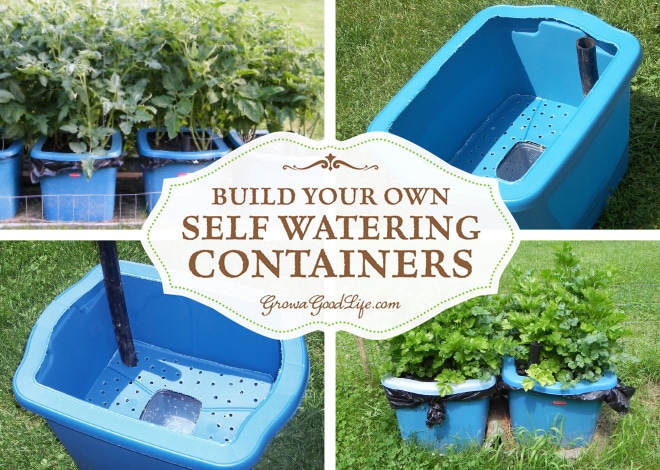
This post on constructing self watering containers out of 18-gallon storage totes was originally written in May 2009 and continues to be popular. I updated the photos, copy, and added additional information.
I still use the original self watering containers each year. I have early blight in my garden soil that often reduces the health and production of my tomato plants. Growing tomatoes in self watering planters allows the plants to grow early blight free for the whole season. Celery also grows very well in self watering pots because they receive a steady moisture level. I have also grown peppers, melons, eggplant, cucumber, and summer squash in self watering containers with great success.
What are Self Watering Containers?
Self watering containers are an enclosed growing system that decreases moisture evaporation and offers a consistent water supply to your plants. It is made up of two chambers, the growing chamber and the water reservoir chamber. The growing chamber contains a wick that descends into the water reservoir that pulls water up into the growing chamber as needed for the plants.
Many versions of self watering containers are sold online. For example, this Self-Watering Planter is almost the same size as an 18 gallon tote. You can make your own self watering container for a fraction of the cost out of some easy to find items.
What are the Benefits of Self Watering Containers?
- Flexible Growing Space: Self watering containers are perfect for container gardens because they can be located anywhere in your yard, on your balcony, or along the edge of your driveway. Place the containers on wheels and you can move them more easily to different locations to take advantage of maximum sun exposure.
- A Consistent Supply of Water: Your plants will have water available to them when they need it and will not suffer from extreme moisture fluctuations that often range between soaking wet and bone dry.
- Provides Moisture to the Roots: When you fill a self watering container, water is stored at the bottom in a separate chamber. Moisture is wicked up into the soil directly to the roots of the plants as needed. In comparison, when you water a traditional container, you add it to the soil surface. If the water doesn’t penetrate deeply enough into the pot, your plants will develop a shallow root system that may stunt growth.
- No Nutrition Loss: Since self watering containers are an enclosed system, nutrients do not get washed away when deep watering like conventional containers.
- Pest and Disease Free: Beginning with fresh growing medium ensures that your plants can become established before pests and disease make their appearance.
- No Weeding: Plastic mulch covers the soil surface preventing weeds seeds from blowing in and sprouting.
How to Build Your Own Self Watering Containers
Materials:
1 18-gallon storage tote with lid (see notes below)
3-4 inch wide container for wicking basket
2 coffee cans to support aeration shelf (see notes below)
24-inch pipe for fill tube, one end slanted
Landscape fabric
1 black plastic garbage bag
Zip ties
1 2 cu ft. bag of organic potting mix (about 52 quarts)
Organic fertilizer
Tools:
Drill with assorted drill bits
Heavy scissors or saw to cut cover
Saw to cut pipe
Marking Pen
Procedure:
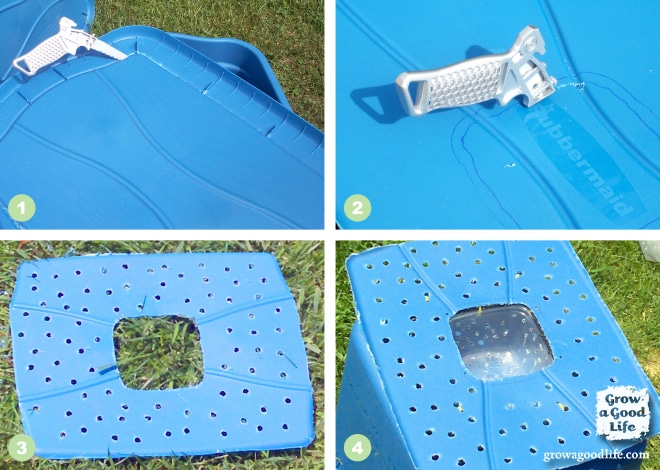
1. Remove the center of the lid. Carefully cut out the center of the lid to be used as the aeration shelf between the soil and the water chamber. Leave about two inches around the lid, so it can be used to hold the plastic mulch to the top of the container later.
2. Cut an opening for the wicking basket. Place your wicking basket at the center of the aeration shelf and trace the edges with your marking pen. Cut the opening slightly smaller (about 1/4-inch) than the outline.
3. Drill holes in the aeration shelf. Drill holes about 1-inch apart for air exchange.
4. Attach Wicking Basket to the aeration shelf. Drill holes a bunch of holes in the wicking basket to allow water to soak through. Drill holes around the edges and attach to the aeration shelf with zip ties.
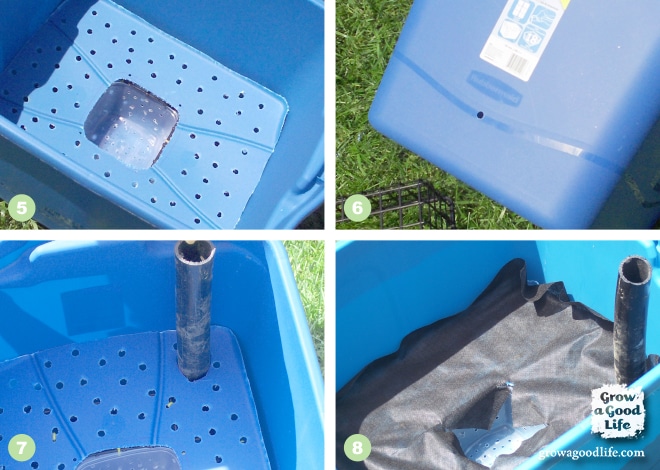
5. Check the fit. Assemble your shelf supports and aeration shelf inside the tote to check the fit. The shelf should fit snug against the tote with no buckling. Trim the shelf if needed.
6. Drill a 1⁄4-inch overfill hole about 1⁄2-inch below the aeration shelf. Water will come out the overfill hole when the container is full. The hole also allows air circulations between the aeration shelf and the water.
7. Cut an opening for the fill tube. Position fill tube, trace an outline, and cut out the hole for the tube.
8. Add landscape fabric. Trim a piece of landscape fabric to cover the aeration shelf. Try to leave a 2-inch overlap. Cut holes for the fill tube and the wicking chamber. The landscape fabric prevents the soil from dropping down into the water reservoir.
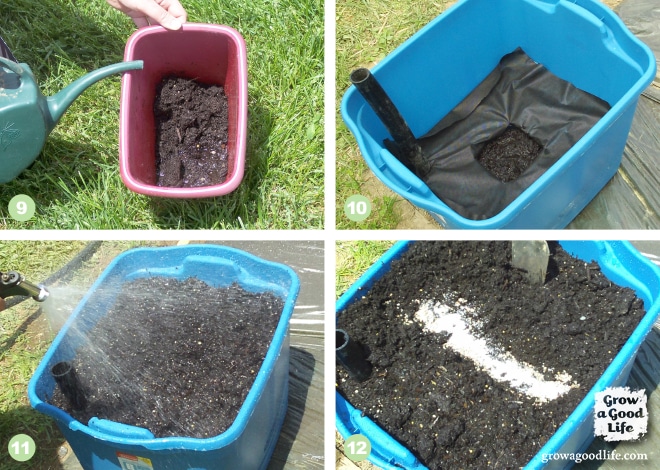
9. Add wet soil to wicking basket. Mix potting soil and water in a container until it is saturated. Pack into the wicking basket.
10. Move container to its final location. Place your self-watering container in its permanent location because it will be too heavy to move after adding the potting mix. Be sure the fill tube is easily reachable to fill with a hose.
11. Fill container with potting mix. Add the rest of the potting mix to the self watering container 3-inches at a time saturating each layer with water until the container is full. This is important, as dry potting mix will not wick water.
12. Add fertilizer. Dig a trench in the soil across the middle of the self watering planter and add 2-cups of fertilizer along the trench. Cover the fertilizer strip with potting mix and water in. Do not mix the fertilizer into the potting mix or spread it around.
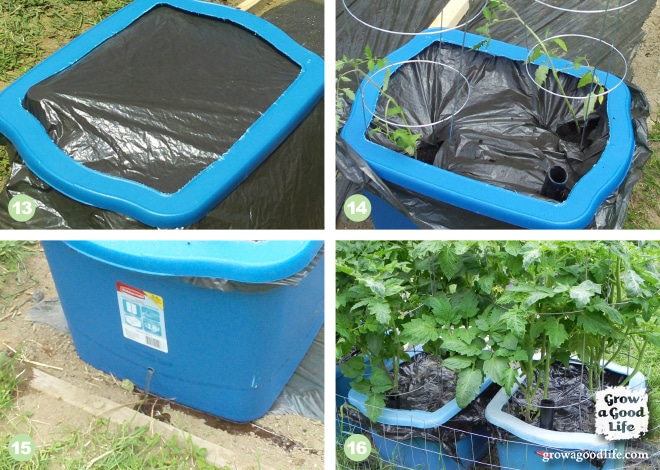
13. Layer plastic mulch. Lay the plastic garbage bag over the filled self watering container and snap on the cover. Cut a hole for the fill tube. The garbage bag will serve as a plastic mulch and help hold moisture in.
14. Plant. Avoiding the fertilizer strip, cut holes in the mulch and add your transplants. I plant two determinant or bush tomato plants in each 18-gallon self watering container, so I cut an X into the solar mulch where the tomatoes will be planted in opposite corners of the self-watering container.
15. Fill water reservoir compartment. Water through the fill tube until water comes out the overfill hole. Add plant supports if necessary. Keep water reservoir full or the wicking action will cease. Top off every day in the heat of summer.
16. Watch your plants grow and enjoy the harvest.
Additional Tips:
- Choose a Good Quality Tote: The Rubbermaid Roughneck and the Sterilite Ultra totes are more flexible and hold up to manipulation without cracking. I found these lovely blue ones on clearance for $5 and these are still being used years later. Simply drain water and store in a shed for winter. You should be able to find these totes at your local big box stores for under $10.
- Aeration Shelf Support: Be sure that whatever you use to hold up the aeration shelf is sturdy enough to support the weight of the potting mix when wet. I use recycled 30 oz. ground coffee containers cut in half to provide a stable shelf.
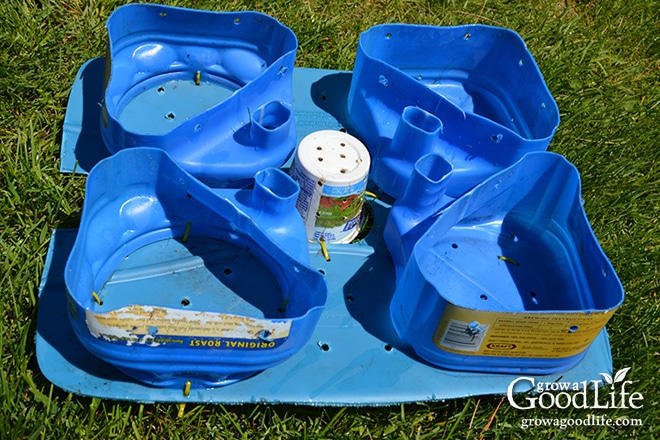
- Wicking Chamber: The wicking chamber container doesn’t need to be very large. I’ve used recycled food storage containers and 8 oz. yogurt containers.
- Potting Mix: Select a good quality, lightweight potting mix suitable for containers or mix your own at the ratio of 45% peat moss, 45% compost, 10% perlite, plus 2 cups of hydrated lime or dolomite. About 2 cubic feet is needed to fill one 18-gallon self watering container.
- Organic Fertilizer: I use Epsoma Plant-tone for growing vegetables and Tomato-Tone for tomatoes.
- Replanting: Reusing self watering planters is easy. Just remove the old plants and old fertilizer strip. Give the soil a deep soaking, replace fertilizer strip, fill reservoir chamber, and replant.
You May Also Like:
- 10 Steps to Starting Seedlings Indoors
- How to Grow Celery from Seed
- How to Harden Off Transplants
- Seasoned Tomato Sauce Recipe for Canning
Good planning is key to a successful vegetable garden
Whether you are new to growing your own food or have been growing a vegetable garden for years, you will benefit from some planning each year. You will find everything you need to organize and plan your vegetable garden in my PDF eBook, Grow a Good Life Guide to Planning Your Vegetable Garden.
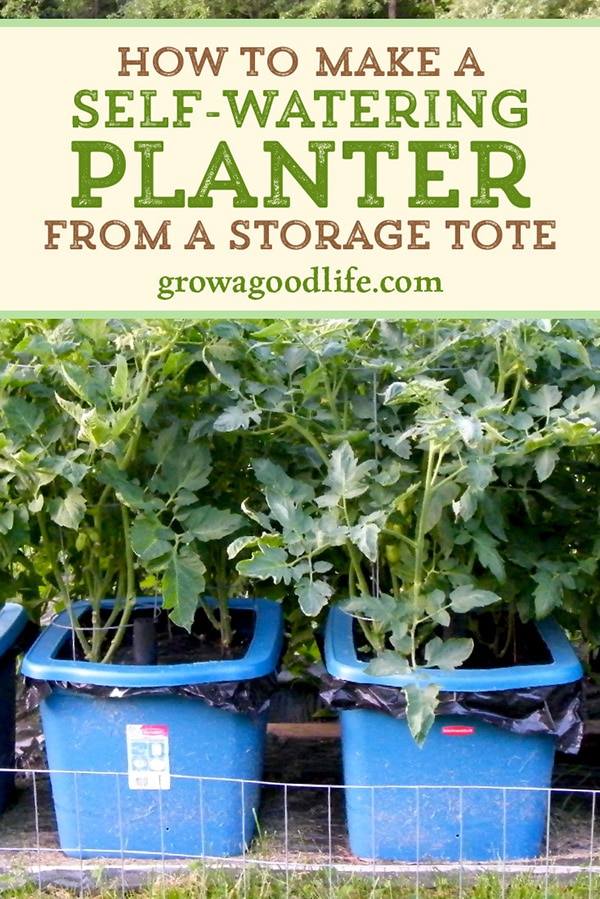


Hi Rachel, I was wondering, what is the approximate height of your reservoir? Also, does the wicking basket need to touch the bottom of the reservoir or can it float slightly above? Thanks!
Lionel, Try to keep the water reservoir at least 3-4 inches so it holds a lot of water. No, the wicking chamber doesn’t have to go all the way to the bottom, just deep enough to be in the water by a few inches. I hope this helps. Please let me know if you have any questions.
Thanks for the prompt reply! Great guide, definitely the best online 🙂
I used the browser’s autocomplete for my name and submitted my question before I realized my full name was entered; Is there any chance you could change my name to simply “Lionel C”? Otherwise, delete the comment and I could resubmit it for the benefit of all.
Lionel
A couple comments: I see you don’t recommend the Sterlite containers. I was considering using the 18 gallon see thru ones as well. I was wondering if anybody else has actually used them and what their experience was. I assume the 18 gallon ones are sturdier than the ones you use for seedlings.
Also, I am really wishing there was a way to print out your whole article for keeping and reference when I’m making my boxes, is that possible?
Hi Linda, I have tried the Sterlite containers and they didn’t last more than a year before cracking. The clear, see through totes are even more brittle. That is why I recommend the Rubbermaid totes. The ones I use have lasted for 7-years. I empty the water and store them in a shed for winter. If you just want to experiment with a few self-watering containers with the Sterlite containers, go for it. Just don’t count on the plastic holding up for very long.
As far as printing the article…You should be able to use the print button in your browser to print it out. If not, let me know and I will work up a document for you to print out.
For printing out such articles for future use, I just right click and scroll down to “copy” all the information I want and ‘paste’ it to a “document’ page. Then I delete the excess I also copy/add the URL address [ https://growagoodlife.com/constructing-18-gal-self-watering-containers-swc/ ] so I can return to the article. This does take a little time, but it is worth it. I also “bookmark” all such treasures to my individual files [ie gardening tips].
I want to make these for my garden next year, have you heard of anybody using 18 gallon Sterlite containers that are seethru (kind of a cloudy white)? I saw them at Walmart and was thinking one could see the water level through them which might be an advantage. Any thoughts?
I use the smaller Sterlite containers as trays for my seedlings under lights. Unfortunately, the Sterlite containers are made of a thin hard plastic that tends to crack easily. I found if the containers are left outside in the sun, they get very brittle and break easily. I do not recommend using these totes for self-watering containers. They would not hold up very long.
Do you know the approximate weight of the finished containers filled with water and ready to plant? I’m wondering if a wooden picnic table would support their weight. Thanks.
Kathy, The containers can get pretty heavy….maybe about 40-50 pounds? I think a good quality picnic table can support a few of these.
you leave out some very important steps.
A. the wicking tub
B. what supports the perimeter of the lid when it is resting on this wicking tub? the whole thing would collapse once you put soil on it.
Hi Jo! I did not leave these steps out. Both are explained and pictured in the article:
A. Wicking tub: “3-4 inch wide container for wicking basket” is listed in the materials list with instructions explained in step 4.
B. Aeration shelf support: “2 coffee cans to support aeration shelf” is listed in the materials and the photo and instructions are under “Addition Tips”
Nice to see this idea of making watering container.Thanks for sharing!
Hi Rachel, do you think this could work with growing hops? It would need a trellis for the vines. Can you do this with bigger totes as well?
Hi Evan, I have never grown hops, but came across this article: https://byo.com/bock/item/1872-growing-hops-in-containers
I think you should try it. Let me know how it turns out.
Is there anything that doesn’t grow very well in these containers? Can’t wait to try them out this year. Thanks.
Elsa, I haven’t found anything yet that doesn’t grow well in self watering containers. I’ve tried tomatoes, peppers, eggplant, lettuce and other leafy greens, herbs, summer squash, and celery. Let me know how you make out.
I’ve planted tomatoes in a tub, and they the bottom leaves are staying yellow. What can I do?
Is it just the bottom leaves that are yellow? Did this happen before you transplanted the tomato to the tub? Once the leaves turn yellow, they don’t usually return to green. Snip the bottom leaves off so the plant can focus energy on new growth.
Thank you, Rachel for all your posts on sustainable living. I really love your post about the “Self – Watering garden container system. I’m here in Texas. We don’t have much of a winter. So I’m really anxious to give this a try!
Thank you, and God bless you for all your work & then sharing it!?
Thank you, Norma for the kind comment. The self watering containers will work wonderfully for you over winter in Texas.
instead of the black fabric maybe you can recycle some of those cloth grocery bags we have too much of. Just cut them open and use them layered or stitch them to make it fit.
Lorrie, That is a good idea. Thanks for sharing that tip. 🙂